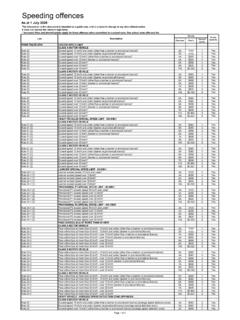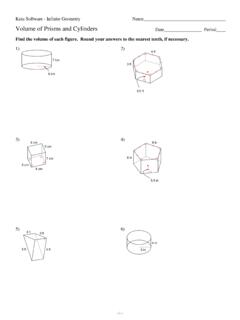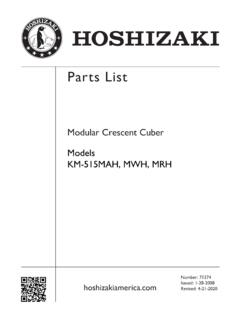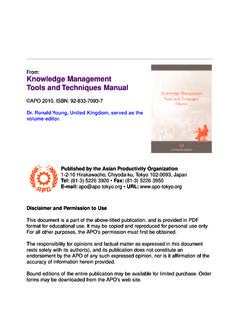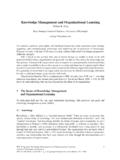Transcription of Significant Figure Rules - Rice University
1 Following are Summaries from Two Chemistry Education Web Sites Concerning Significant Figure Rules From There are three Rules on determining how many Significant figures are in a number: 1. Non-zero digits are always Significant . 2. Any zeros between two Significant digits are Significant . 3. A final zero or trailing zeros in the decimal portion ONLY are Significant . Focus on these Rules and learn them well. They will be used extensively throughout the remainder of this course. You would be well advised to do as many problems as needed to nail the concept of Significant figures down tight and then do some more, just to be sure. Please remember that, in science, all numbers are based upon measurements (except for a very few that are defined).
2 Since all measurements are uncertain, we must only use those numbers that are meaningful. A common ruler cannot measure something to be cm long. Not all of the digits have meaning (significance) and, therefore, should not be written down. In science, only the numbers that have significance (derived from measurement) are written. If you're not convinced Significant figures are important, you may want to read the Significant Figure Fable that follows. Rule 1: Non-zero digits are always Significant . Hopefully, this rule seems rather obvious. If you measure something and the device you use (ruler, thermometer, triple-beam balance, etc.) returns a number to you, then you have made a measurement decision and that ACT of measuring gives significance to that particular numeral (or digit) in the overall value you obtain.
3 Hence a number like would have four Significant figures and would have three. The problem comes with numbers like or Rule 2: Any zeros between two Significant digits are Significant . Suppose you had a number like 406. By the first rule, the 4 and the 6 are Significant . However, to make a measurement decision on the 4 (in the hundred's place) and the 6 (in the unit's place), you HAD to have made a decision on the ten's place. The measurement scale for this number would have hundreds and tens marked with an estimation made in the unit's place. Like this: 1 Rule 3: A final zero or trailing zeros in the decimal portion ONLY are Significant . This rule causes the most difficulty with ChemTeam students.
4 Here are two examples of this rule with the zeros this rule affects in boldface: Here are two more examples where the Significant zeros are in boldface: x 10 5 x 1012 What Zeros are Not Discussed Above Zero Type #1: Space holding zeros on numbers less than one. Here are the first two numbers from just above with the digits that are NOT Significant in boldface: These zeros serve only as space holders. They are there to put the decimal point in its correct location. They DO NOT involve measurement decisions. Upon writing the numbers in scientific notation ( x 10 3 and x 10 2), the non- Significant zeros disappear. Zero Type #2: the zero to the left of the decimal point on numbers less than one.
5 When a number like is written, the very first zero (to the left of the decimal point) is put there by convention. Its sole function is to communicate unambiguously that the decimal point is a decimal point. If the number were written like this, .00500, there is a possibility that the decimal point might be mistaken for a period. Many students omit that zero. They should not. Zero Type #3: trailing zeros in a whole number. 200 is considered to have only ONE Significant Figure while 25,000 has two. This is based on the way each number is written. When whole number are written as above, the zeros, BY DEFINITION, did not require a measurement decision, thus they are not Significant . However, it is entirely possible that 200 really does have two or three Significant figures .
6 If it does, it will be written in a different manner than 200. 2 Typically, scientific notation is used for this purpose. If 200 has two Significant figures , then x 102 is used. If it has three, then x 102 is used. If it had four, then is sufficient. See rule #2 above. How will you know how many Significant figures are in a number like 200? In a problem like below, divorced of all scientific context, you will be told. If you were doing an experiment, the context of the experiment and its measuring devices would tell you how many Significant figures to report to people who read the report of your work. Zero Type #4: leading zeros in a whole number. 00250 has two Significant figures .
7 X 10 4 has three. Exact Numbers Exact numbers, such as the number of people in a room, have an infinite number of Significant figures . Exact numbers are counting up how many of something are present, they are not measurements made with instruments. Another example of this are defined numbers, such as 1 foot = 12 inches. There are exactly 12 inches in one foot. Therefore, if a number is exact, it DOES NOT affect the accuracy of a calculation nor the precision of the expression. Some more examples: There are 100 years in a century. 2 molecules of hydrogen react with 1 molecule of oxygen to form 2 molecules of water. There are 500 sheets of paper in one ream.
8 Interestingly, the speed of light is now a defined quantity. By definition, the value is 299,792,458 meters per second. Are Significant figures Important? A Fable A student once needed a cube of metal that had to have a mass of 83 grams. He knew the density of this metal was g/mL, which told him the cube's volume. Believing Significant figures were invented just to make life difficult for chemistry students and had no practical use in the real world, he calculated the volume of the cube as mL. He thus determined that the edge of the cube had to be cm. He took his plans to the machine shop where his friend had the same type of work done the previous year. The shop foreman said, "Yes, we can make this according to your specifications - but it will be expensive.
9 " "That's OK," replied the student. "It's important." He knew his friend has paid $35, and he had been given $50 out of the school's research budget to get the job done. He returned the next day, expecting the job to be done. "Sorry," said the foreman. "We're still working on it. Try next week." Finally the day came, and our friend got his cube. It looked very, 3very smooth and shiny and beautiful in its velvet case. Seeing it, our hero had a premonition of disaster and became a bit nervous. But he summoned up enough courage to ask for the bill. "$500, and cheap at the price. We had a terrific job getting it right -- had to make three before we got one right.
10 " "But--but--my friend paid only $35 for the same thing!" "No. He wanted a cube cm on an edge, and your specifications called for We had yours roughed out to that very afternoon, but it was the precision grinding and lapping to get it down to which took so long and cost the big money. The first one we made was on one edge when we got finshed, so we had to scrap it. The second was closer, but still not what you specified. That's why the three tries." "Oh!" Rules for Rounding Off Now that "everyone" has a calculator that will give a result to six or eight (or more) figures , it is important that we know how to round the answer off correctly. The typical rule taught is that you round up with five or more and round down with four or less.
